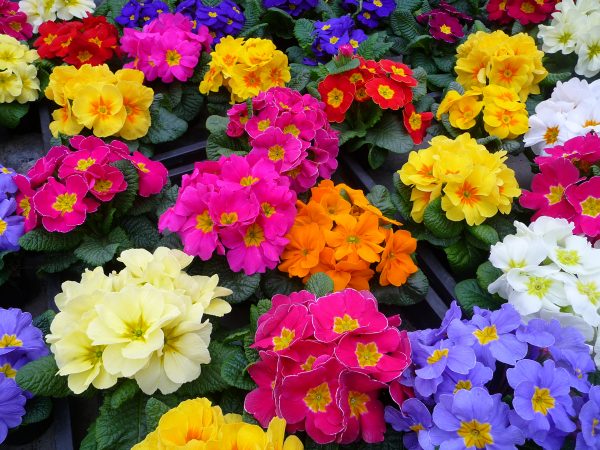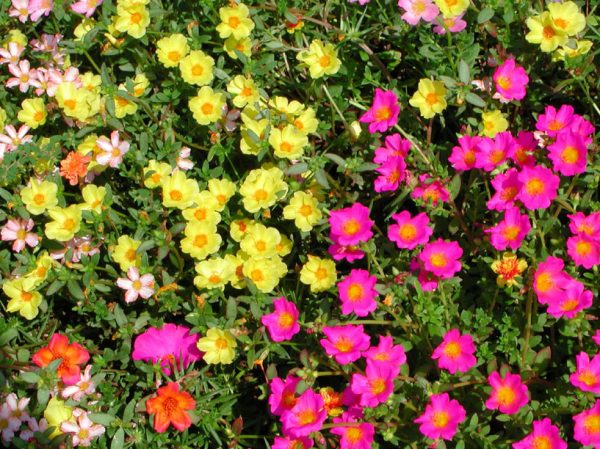How to grow low-growing flowers for a flower bed that bloom all summer
Content
Basic principles of plant care
The basis of the principle of caring for flowers and shrubs in a flower bed in summer is reduced to the laws of harmony in terms of combining flowers in one area, as well as observing traditional sowing rules. Of course, there is no place for weeds and debris in a flower bed. To avoid spending a lot of time caring for blooming beauty, it is important before planting to determine the types of low-growing flowers and shrubs that can replace each other during the flowering period, thereby creating a continuous colored carpet in spring, summer and autumn.
In order for a flower garden in which there are perennials and annuals to please you as long as possible, you should adhere to the following principles for caring for plants:
- Planting plants at a certain distance. Too close proximity can cause the stem to pull out.
- Plants and shrubs should cover their entire area to create a solid green or floral carpet.
- It is important to calculate the frequency and duration of flowering of each species in a flower bouquet.
- After planting seedlings or embedding seeds in the soil, be sure to water them.
- If after transplanting the seedling does not take root, it must be replaced with a new one of the same type, color and growth.
- As long as the height of the plants allows, carry out weeding and loosening of the soil, especially if the summer is hot.
- With the transition of plants in the summer to the stage of active growth, it is necessary to carry out the first feeding with organic matter or mineral agrochemicals. Do not apply a lot of nitrogen, as it only stimulates the growth of the shoots.
- After the shrub fades, watch out for the timely removal of the inflorescences.
Compliance with simple recommendations will allow you to admire the beauty of flowering low-growing plants from early spring to late autumn.
Video "Selection of varieties of flowering plants"
Video selection of different varieties of flowering plants.
Perennial undersized flowers
To make the flower garden pleasing to the eye during spring, summer and autumn, it is recommended to plant annual and perennial plants at the same time. Of course, annuals are the juiciest riot of colors throughout the season, however, many still prefer perennials. The fact is that perennial flowering crops can be grown in one place for 2-3 years. As for sudden spring or autumn frosts, for the majority of representatives of this class, they are not terrible. Caring for perennial plants does not require much time and effort. Landscaping is much cheaper, as after 2-3 years the plant will be ready for repotting and division.
The most beautiful flower beds look, in which perennial flowering plants are grouped according to their growth, or there is a harmonious carpet only from stunted perennials.At the same time, undersized perennials look great against the background of their taller counterparts. This category includes plants up to 30 cm. Below is an assortment of the most popular low-growing crops:
- Pansies are a very beautiful perennial of the original shape of flowers and incredible colors from pale white to almost black;
- dwarf phlox is able to create a continuous “carpet” of multi-colored paints from snow-white to purple;
- a good decoration option - gentian;
- Obrienta are small purple flowers.
- Aquilegia is a flower of an unusual shape (yellow core and pale pink oval petals at the edges) can be of a wide variety of colors;
- a dwarf aster of lilac and purple, pale pink and snow-white white color will look very beautiful among low-growing shrubs.
Low-growing annual flowers
It is possible to create a magnificent bright landscape on a flower garden and even a small flower bed from undersized annuals. The main feature of annual flowering plants is that they are able to go through the entire growing cycle during one season and delight with bright flowering throughout the summer.
Traditionally, flower beds are shaped like a circle and a crescent. The most common plants of one year of life are fragrant petunia, purslane and marigolds. The advantages of planting are that every year you can create a completely different landscape on your site.
Growing conditions and maintenance
In order for a simple flower bed to please you throughout the warm season, it is important to observe the simple conditions for growing and maintaining the site. To do this, use our tips:
- Many flowers turn their heads to follow the sun, so consider this factor when planning your site. If the view of the flower garden will still open from the north, we recommend planting marigolds, irises, delphinium and zinnias, since they do not follow the sun.
- If you plan to set up a flower bed along the fence, you should plant shrubs and flowers after you decide on the question: who should be pleased with beauty - you or passers-by.
- Observe the distance between the plants, otherwise in the middle of summer you will have to pull out individual specimens due to lack of space.
- Remove the timely removed inflorescences from annuals and perennials.
The maintenance and care of a bush flower bed will require less time and effort, since it is quite simple to remove weeds in a timely manner and plant new plants at will. Annual plants require planting and more careful maintenance each season.
How to combine flowers in flower beds
A flower garden is an endless field for imagination, since in the world of flora, opposites can also attract, and two seemingly different plants give a wonderful tandem. There is no unambiguous rule for combining flowers in a flower garden, since everyone decides for himself what he wants to see in the end:
- color combination;
- tandem in the shape of leaves and petals of plants;
- the period and frequency of flowering of the plant.
If color combination is important, then nasturtium and marigolds will help you create a warm sunny atmosphere, and forget-me-nots will make the flower bed modest, but insanely delicate, the flower garden will become more refined with lilies. The following rule is important here - yellow shades attract attention, while cool shades of green, blue and purple are best used for the background. The tandem in the shape of the leaves is relevant if the flower garden is performed according to the tone-on-tone principle or small-flowered plants coexist with large-flowered ones.
To ensure flowering from early spring to late autumn, it is best to plant annuals, perennials and bulbs. The very first to open the ensemble of colors were representatives of bulbous: tulips and daffodils, viola and crocuses. At the beginning of summer, they give way to biennials - daisies, violets and forget-me-nots, as well as luxurious peonies and irises.Closer in the middle of summer, the annuals bloom - petunia and calendula. Everyone can create beauty from flowering plants in the summer on their own plot, if you follow simple recommendations and remove weeds in time.
Video "The best varieties of flowers"
Informational video with helpful tips for flower varieties.




